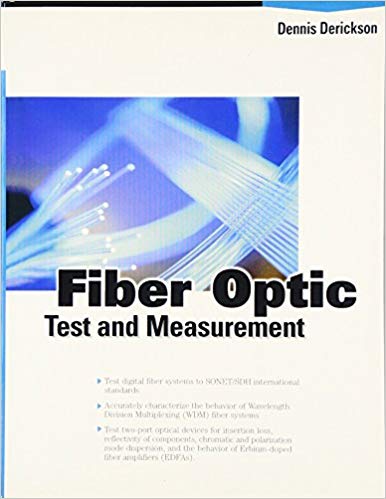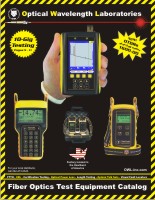| OPTICAL WAVELENGTH LABORATORIES TRAINING COURSES |
|
COURSE NAME: FIBER OPTIC TEST AND MEASUREMENT The course instructor, Dan Welch, has been involved with datacomm and cabling since the early 1980’s. Dan is currently the chief engineer at Optical Wavelength Laboratories which involves him with the design of a complete line fiber optic test and measurement equipment. Dan’s many accomplishments include his assistance in the development of satellite to US Navy submarine communications systems. Dan’s career has included training university and information technology personnel in the field of telecommunications. More... |
 The text book, Fiber Optic Test and Measurement, by Dennis
Derickson (editor)(ISBN#: 0-13-534330-5), is well received
as a text in the fiber optics field. It is geared
for fiber optics professionals who have a strong
background in the principles of mathematics and science,
and want to learn more about the specifics behind fiber
optics test and measurement technologies and techniques. The text book, Fiber Optic Test and Measurement, by Dennis
Derickson (editor)(ISBN#: 0-13-534330-5), is well received
as a text in the fiber optics field. It is geared
for fiber optics professionals who have a strong
background in the principles of mathematics and science,
and want to learn more about the specifics behind fiber
optics test and measurement technologies and techniques.FROM THE PUBLISHER This is the most authoritative, complete source of test and measurement information for engineers who design and maintain fiber optic networks. This book presents measurement principles for characterizing all three basic components of a fiber optic communication system: the optical transmitter, fiber medium and optical receiver. It also covers system level measurements, and discusses the principles and limitations of current fiber optic testing equipment. It discusses testing to SONET/SDH international standards, and helps engineers choose the best approach to testing today's new erbium doped fiber amplifiers. The book provides detailed recommendations for understanding polarization states, and presents new methods for accurately characterizing the behavior of Wavelength Division Multiplexing (WDM) fiber systems. It includes detailed coverage of testing fiber in the local loop, using optical power meters and optical time domain reflectometers. It also reviews the latest state-of-the-art 10 Gb/s systems, and even faster systems on the horizon. The coverage is practical, helping professionals accurately measure and test fiber optic systems without becoming experts in theory. Book Pages: 642 |
|
UNIT 1: Introduction to Fiber Optic Systems and Measurement 1.1 -- Introduction 1.2 -- Fiber Optic Links: The Basics 1.3 -- Digital Communications Links 1.4 -- Wavelength Division Multiplexed Systems 1.5 -- Analog Links 1.6 -- Characterization of Digital Fiber-Optic Links 1.7 -- Optical Fibers and Two-Part Optical Components 1.8 -- Measurement of Optical Fiber and Two-Part Optical Components 1.9 -- Optical Transmitters 1.10 -- LEDs 1.11 -- Optical Receivers 1.12 -- Optical Transmitter and Receiver Measurements Appendix: Relationships Between Wavelength and Frequency UNIT 2: Optical Power Measurement 2.1 -- Introduction 2.2 -- Power Meters with Thermal Detectors 2.3 -- Power Meters with Photodetectors 2.4 -- Absolute Power Measurement 2.5 -- Responsivity Calibration 2.6 -- Linearity Calibration 2.7 -- Summary UNIT 3: Optical Spectrum Analysis 3.1 -- Introduction to Optical Spectrum Analysis 3.2 -- Types of Optical Spectrum Analyzers 3.3 -- Anatomy of a Diffraction-Grating-Based Optical Spectrum Analyzer 3.4 -- Operation and Key Specifications of Diffraction-Grating-Based Optical Spectrum Analyzers 3.5 -- Spectral Measurements on Modulated Signals 3.6 -- OSA Application Examples 3.7 -- Summary UNIT 4: Wavelength Meters 4.1 -- Introduction 4.2 -- The Michelson Interferometer Wavelength Meter 4.3 -- Wavelength Meters in Multiple Signal Environments 4.4 -- Absolute Wavelength Accuracy Considerations for Michelson-Interferometer Wavelength Meters 4.5 -- Michelson Wavelength-Meter Measurement Considerations 4.6 -- Alternate Wavelength Meter Techniques 4.7 -- Summary UNIT 5: High Resolution Optical Frequency Analysis 5.1 -- Introduction 5.2 -- Basic Concepts 5.3 -- Laser Linewidth Characterization 5.4 -- Optical Spectral Measurement of a Modulated Laser 5.5 -- Laser Chirp Measurement 5.6 -- Frequency Modulation Measurement 5.7 -- Summary UNIT 6: Polarization Measurements 6.1 -- Introduction 6.2 -- Polarization Concepts 6.3 -- Retardance Measurement 6.4 -- Measurement of Cross-Talk in Polarization-Maintaining Fiber 6.5 -- Summary UNIT 7: Intensity Modulation and Noise Characterization of Optical Signals 7.1 -- Modulation Domain Analysis 7.2 -- Modulation Transfer Function 7.3 -- Modulation Signal Analysis 7.4 -- Intensity Noise Characterization 7.5 -- Modulation Domain Calibration Techniques UNIT 8: Analysis of Digital Modulation on Optical Carriers 8.1 -- Digital Fiber-Optic Communications Systems 8.2 -- Bit-Error Ratio 8.3 -- Eye-Diagram Analysis 8.4 -- Mask Measurements 8.5 -- Jitter Testing UNIT 9: Insertion Loss Measurements 9.1 -- Introduction 9.2 -- How the Component Influences the Measurement Technique 9.3 -- Single-Wavelength Loss Measurements 9.4 -- Uncertainties of Single-Wavelength Loss Measurements 9.5 -- PDL Measurement 9.6 -- Introduction to Wavelength-Dependent Loss Measurements 9.7 -- Wavelength-Dependent Loss Measurements Using a Tunable Laser 9.8 -- Wavelength-Dependent Loss Measurements Using a Broadband Source 9.9 -- Summary UNIT 10: Optical Reflectometry for Component Characterization 10.1 -- Introduction 10.2 -- Total Return Loss Technique 10.3 -- Basic Concepts for Spatially Resolved Reflectometry 10.4 -- Optical Low Coherence Reflectometry 10.5 -- Survey of Different Techniques 10.6 -- Comparison of Techniques UNIT 11: OTDRs and Backscatter Measurements 11.1 -- Introduction 11.2 -- Principle of OTDR Operation 11.3 -- Fiber Loss, Scatter, and Backscatter 11.4 -- Measuring Splice- and Connector Loss 11.5 -- Return Loss and Reflectance 11.6 -- Automated Remote Fiber Testing 11.7 -- Outlook UNIT 12: Dispersion Measurements 12.1 -- Introduction 12.2 -- Measurement of Intermodal Dispersion 12.3 -- Measurement of Chromatic Dispersion 12.4 -- Polarization-Mode Dispersion 12.5 -- Summary UNIT 13: Characterization of Erbium-Doped Fiber Amplifiers 13.1 -- Fiber Amplifiers 13.2 -- Gain 13.3 -- Noise 13.4 -- Noise Figure 13.5 -- Characterization of Gain and Noise Figure 13.6 -- Other Types of Optical Amplifiers 13.7 -- Sources of Measurement Errors 13.8 -- Useful Constants for EDFA Measurements 13.9 -- Summary Appendix A: Noise Sources in Optical Measurements A.1 -- Electrical Thermal Noise A.2 -- Optical Intensity Noise A.3 -- Photocurrent Shot Noise A.4 -- Optical-Phase-Noise to Intensity-Noise Conversion A.5 -- Summary Appendix B: Nonlinear Limits for Optical Measurements B.1 -- Raman Limit B.2 -- Self-Phase Modulation B.3 -- Brillouin Limit B.4 -- Summary Appendix C: Fiber Optic Connectors and Their Care C.1 -- Background C.2 -- Connector Styles C.3 -- Connector Design C.4 -- Connector Care C.5 -- Cleaning Procedures |
|


